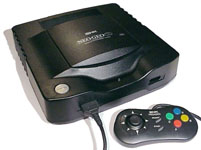
A Very Simple Hack: making your own cable

A Very Simple Hack: making your own cable
The Megadrive, Sega Master System, and Neo-Geo all output RGB video from their "A\V OUT" connectors in the back. So, connecting them to a monitor is simply a matter of getting (or making) the right cable for their connectors. They all use an 8-pin DIN connector, HOWEVER, the Neo-Geo uses a C-shaped DIN(grey cable), while the SMS/MD use a U-shaped DIN(black cable). Thanks, guys! |
|
As I couldn't get a Neo-Geo RGB cable, and as SMS/MD RGB cables can't be had(?) in Japan, I made my own. I cannibalized an
unused SFC RGB cable and cut it in half. On one end is the 21-pin plug,
on the other, I made a SUB-D connector so that I could easily connect
and disconnect different systems/cables without having to constantly fiddle
with different 21-pin connectors. |
While I was at it, I put a language switch in my NGCD. To keep the rear panel nice and clean, I installed a small switch very inconspicuously inside the CD compartment, in one of the corners. It's a hell of a lot better than some huge toggle in the back! |
Let's rate the systems!
(Note that I am not comparing composite quality against RGB quality, but
rather each quality against the best that Composite or RGB has
to offer, respectively.) |
Composite Quality |
RGB Quality |
|
 |
Composite quality on the MD/Genesis is not so high. Blurry graphics? Check. Dark output? Check. Colour fringing? Check. Horrible rainbow interference pattern? Check! The main problem is that the MD -- in fact all the systems on this page -- does nothing to eliminate the dot pattern produced by NTSC colour encoding. While other contemporary systems (such as the SFC or PC-Engine) had circuitry to average the colour encoding artifacts out over time, the MD does not. Thus, bright colours have a bad dithering pattern applied to them, and vertical stripes of graphics produce the aforementioned rainbow effect. Not so great. The improvement in image quality from composite to RGB is quite a surprise, then. The MD's RGB display is nice and sharp, with very bright colours coming over the cables. The only downside is that I can see some vertical lines in the blue colour component. The SMS has this problem in RGB and composite too. Oh, well. |
||
 |
The Japanese SMS uses the same type of NTSC encoder, if not the same encoder, as the Megadrive. Thus, the same problems that apply to the MD apply to the SMS as well. The SMS has a lower horizontal resolution (256 pixels) than the MD (320 usually), so the fringing and artifacts between pixels aren't as bad. However, anyone who has played on a US SMS can tell you that the image quality is quite horrible. It might just be a figment of my imagination, but the US SMS' composite video is far worse than its Japanese counterpart. They must have used a cheap video encoder, as all graphics are terribly ill-defined and fringe over several adjacent pixels. Awful! So of course, I'm happy to report that the RGB video produced by the SMS is bright and bold. All graphics are very crisp. What an improvement! |
JP SMS: US SMS: |
|
 |
The Neo-Geo is pretty notorious for having dark, blurry, low-quality composite video. The NGCD that I have produces pretty good composite video, in that it's bright and a bit sharp. Saturated colours, however, produce the dreaded colour dithering that somehow seems worse than on the Megadrive. It is actually difficult to read red text over a black background on the Neo-Geo. The Neo-Geo is also notorious for having iffy RGB video, with visible vertical lines on some models. Mine seems fine though, so I have to say the RGB quality is excellent. Colours are bright, sharp, and don't bleed. Great! |
||
Now, you can see what I mean on the SCREENSHOTS PAGE,
or return to the main page.